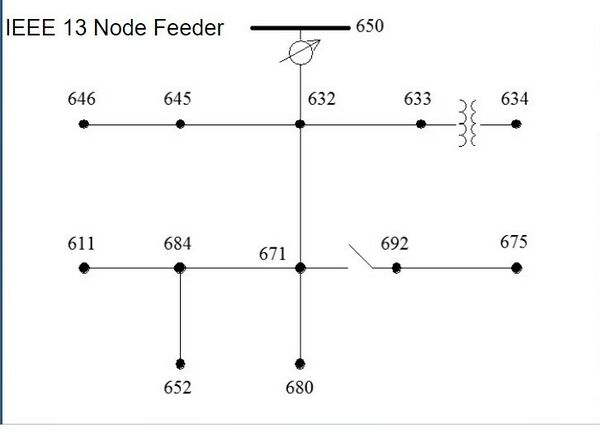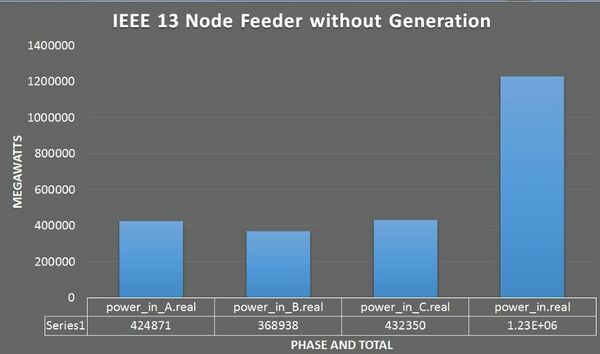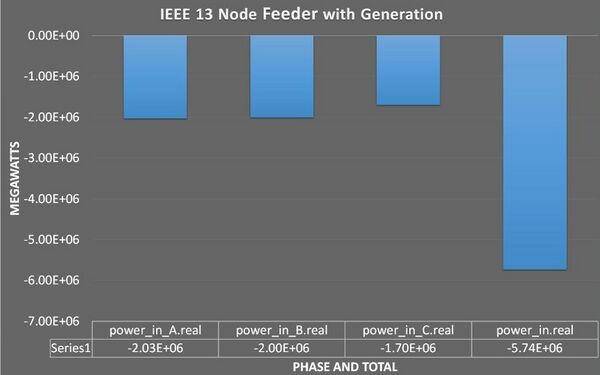Non-Wire Solutions to Traditional Power Grid Upgrades
| Team Name | Non-Wire Solutions to Traditional Power Grid Upgrades |
| Faculty Adviser | Dr. Herb Hess |
| Client | Avista Utilities
|
| Duration | Fall 2017 - Spring 2018 |
| Team Members |
|
The objective of this project is to develop a distribution planning analysis tool to evaluate the capacity of a distribution feeder. This analysis will find the maximum capacity of distributed energy resources, DERs, that can be added to an existing distribution feeder without the need of traditional power grid upgrades to the system. The scope of this project involves researching various potential outlines for planning future action in the development of an analysis method from utility companies and testing the analysis on an IEEE feeder. Then transitioning to tests on a distribution feeder provided by the client that could possibly benefit from distributed energy resources.
Problem Statement[edit | edit source]
The relationship between the electric utility and its customers is changing. Utilities are becoming less retailers of a commodity and more brokers of energy resources. Customers want to build their own clean energy resources to meet their local demand but with the same reliability typical of their electric utility. For this new relationship, the utility wants a new sustainable planning process to integrate high levels of clean energy resource into their existing distribution planning process.
Initial Design Ideas[edit | edit source]
- Smart Inverter
- Operate PV cells at lower efficiency to aid in voltage regulation via reactive power generation/consumption
- Energy Storage
- Local power regulation to help the local loads at peak times during the day.
- May be used in tandem with PV cells to add to the operational capacity of the auxiliary system.
- Smart Meters
- Used by the utility or requested by the customer to ensure the greatest efficiency of the local load consumption.
Scope and Analysis[edit | edit source]
The scope of this project includes working with the model of the feeder associated with the Carlin Bay project. This feeder model was provided by Avista as an application case. The model was provided in the format of a Common Information Model. A Common Information Model is an attempt to establish a uniform language and domain model for energy systems and related systems. This allows for an integrated platform to connect different applications. This first step in running an analysis of this feeder is to convert it to the file format that the distribution analysis software we are using can read. The analysis software used for this project is a Pacific Northwest National Lab software called GridLAB-D. GridLAB-D is a power distribution system simulation software with a flexible simulation environment that can be integrated with a variety of third-party data management and analysis tools. It also has many built in distributed energy resource models. The next part of the project is to do an integration capacity analysis of small test feeder to provide a proof of concept then work on scaling up that analysis to work with the application case feeder.
Design[edit | edit source]
| Design Process | |||||||||||
|---|---|---|---|---|---|---|---|---|---|---|---|
| First Steps | The first step in our design will be determining the integration capacity of the circuit. Integration Capacity” is the amount of DER capacity that can be installed on a distribution circuit without requiring significant
distribution upgrades. From our locational value analysis research we know that the most successful locations are where the installation of DER’s will not require significant upgrades. | ||||||||||
| Software | Gridlab-D | ||||||||||
| Capacity Testing Design |
| ||||||||||
| Distributed Energy Resources, (DERs), under consideration |
| ||||||||||
| Solutions |
| ||||||||||
| Next steps |
| ||||||||||
Power World Model[edit | edit source]
CIM to GridLAB-D converter[edit | edit source]
The CIM to GridLAB-D converter uses a javascript to convert CIM file to GridLAB-D file format. This is accomplished by using a file parsing software called BlazeGraph and a method known as SQL Queries. BlazeGraph is a workspace in a local host that when properly utilized can parse the CIM file and output various kinds of data to the inquiring program. The senior design team used this Blazegraph converter and are still working with it, but some objects are unable to be converted at this time. The objects that are unable to be converted are fusses and disconnectors. The converter successfully converted the CIM file to GridLAB-D and fuses and disconnectors were replaced with load break switches. There are still some issues associated with the converted file and some more work is need to get the file working properly. It is also worth noting that the PNNL converter works most consistently with a true Linux operating system.
Capacity Analysis Results[edit | edit source]
The integrated capacity analysis, ICA, shown above was applied to an IEEE 13 node test feeder shown in figure 1 as a proof of concept scenario.
Figure 1: IEEE 13 Node Test Feeder
What was found was that under normal operation conditions a 9 megawatt generator could be added at node 671. This was the maximum generation that could be added to the feeder and any more would overload the line between nodes 671 and 632. Another thing that was found was that optimally generation should be added on the high voltage side of any transformers because the transformers were normally operating closer to their limits than the lines. The main constraint that was looked at was the current limits of the lines. Another thing that could be looked at is the voltages at each of the buses in the system. These values were recorded but not analyzed in detail.
Addition of the 9 megawatt generator to the system caused reverse power flow within the system. This happens because the additional generation is supplying the power to all the loads in the system. The additional power that was not going to the loads is then sent back to the substation and distributed elsewhere. Figure 2 shows the real power at the substation under normal operating conditions.
Figure 2: Power Flow Without ICA
Figure 2 shows that under normal operating conditions the power at the substation is positive. This indicates that the power is flowing from the substation to the system. Figure 3 shows the real power at the substation after the addition of a 9 megawatt generator.
Figure 3: Power Flow With ICA (Reverse Power Flow)
Figure 3 shows that with the addition of a generator on the system the real power at the substation is negative. This indicates that power is flowing from the system back into the substation
Deliverables[edit | edit source]
- Research Report Nov 17th
- Report summarizing topics that are of interest to the client.
- Gridlab-D Model April 9th 2018
- Develop a model using the Software Gridlab-D to aid the client in future scenario simulation.
- Final Report May 1st
- Final Project report summarizing the year of research and fulfilling all the normal capstone requirements.
Next Steps[edit | edit source]
The Carlin bay feeder will need to be updated to include line configurations and parameters. Currently a team at Washington State University is developing line models for the Carlin Bay feeder. The parameters will need to be applied to the Common Information Model and the converter rerun to get a working model of the Carlin Bay feeder. When a working model of the feeder is obtained the integration capacity analysis that was ran on the IEEE 13 node feeder will be scaled to the Carlin bay feeder. After the capacity is found location net benefits will be applied to the feeder and operational guidelines will be laid out to determine which distributed energy resources should be added, when to add them, and how to equip them with smart inverters for interface in operational scenarios
Team Members[edit | edit source]
| A Reactive Future Team | |||||
|---|---|---|---|---|---|
| Member | Biography | Discipline | |||
| Nick Flynn | Senior in electrical engineering with an emphasis in power. | Electrical Engineering | |||
| Maximilian Schnitker | Senior in Electrical Engineering graduating in May of 2018 with an emphasis in Power | Electrical Engineering | |||
| Tianyi Chen | Senior in Electrical Engineering with an emphasis in power systems | Electrical Engineering | |||
| Barjas Alruwaili | Senior in Electrical Engineering with an emphasis in power system area | Electrical Engineering | |||





